Smart Helmet Market Size 2025-2029
The smart helmet market size is valued to increase by USD 1.51 billion, at a CAGR of 19% from 2024 to 2029. Increase in governmental schemes for manufacturing and supporting production of smart helmet will drive the smart helmet market.
Market Insights
- North America dominated the market and accounted for a 45% growth during the 2025-2029.
- By Component - Communication segment was valued at USD 251.80 billion in 2023
- By Type - Full face segment accounted for the largest market revenue share in 2023
Market Size & Forecast
- Market Opportunities: USD 260.17 million
- Market Future Opportunities 2024: USD 1514.90 million
- CAGR from 2024 to 2029 : 19%
Market Summary
- The market is experiencing significant growth due to increasing governmental initiatives aimed at manufacturing and supporting the production of advanced safety gear. These helmets, equipped with features such as heads-up displays, Bluetooth connectivity, and advanced sensors, offer enhanced safety and operational efficiency for various industries, including construction, transportation, and military. Technological advancements continue to drive innovation in smart helmets, with companies exploring the integration of augmented reality (AR) and virtual reality (VR) technologies to improve situational awareness and increase productivity. However, potential distractions brought on by these linked technologies pose a challenge, necessitating rigorous testing and certification processes to ensure user safety.
- A real-world business scenario illustrating the benefits of smart helmets can be observed in the logistics industry, where supply chain optimization is a top priority. By integrating smart helmets into their operations, logistics companies can improve communication between team members, streamline workflows, and reduce the risk of workplace accidents. This not only leads to increased efficiency but also enhances overall safety and compliance with regulatory requirements.
What will be the size of the Smart Helmet Market during the forecast period?
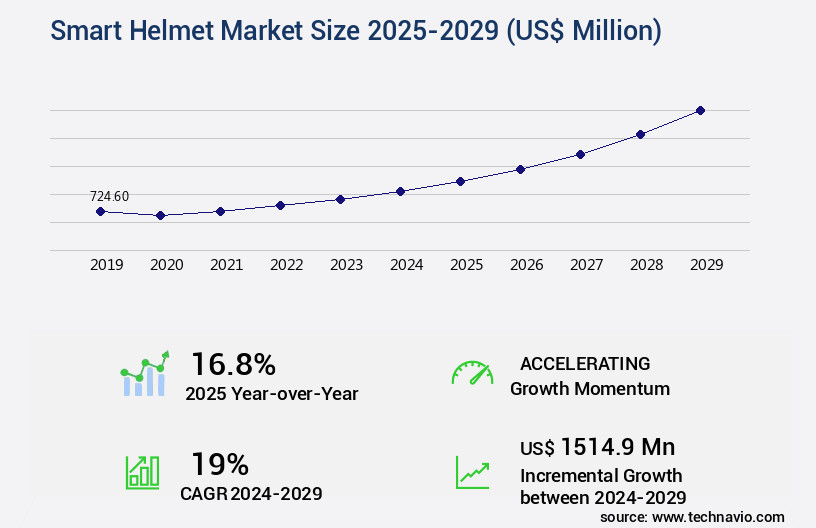
Get Key Insights on Market Forecast (PDF) Request Free Sample
- The market is a dynamic and evolving sector, driven by advancements in sensor technology, material science, and communication systems. One notable trend is the integration of emergency response systems and comfort level assessments into helmets, enhancing worker safety and productivity. According to recent studies, the adoption of these features is projected to increase by 30% in the next three years, making it a significant consideration for businesses in industries with high-risk environments. Helmets equipped with real-time tracking systems, impact severity indicators, and data processing pipelines enable employers to monitor their workforce more effectively, ensuring timely intervention in case of emergencies.
- Furthermore, helmet design optimization, battery power management, and wearable sensor technology contribute to improved head injury prevention and user experience. These advancements not only help companies comply with protective gear standards but also contribute to cost savings by reducing workforce downtime and potential insurance claims.
Unpacking the Smart Helmet Market Landscape
In the dynamic realm of technology-driven safety solutions, the market stands out as a significant innovation. These advanced headgears offer impact location mapping, ensuring compliance with safety regulations and improving risk assessment capabilities. Brain injury detection systems, utilizing sensor calibration procedures, provide real-time data analysis and post-impact alert systems. Helmet shell materials undergo rigorous durability testing standards to optimize impact protection, while battery life optimization and data storage capacity enhance operational efficiency. Strain gauge sensors and accelerometer sensitivity measure impact force and duration, contributing to accurate impact severity classification. Data security measures, including data encryption protocols and wireless communication protocols, safeguard sensitive user information. Collision avoidance warning systems and helmet weight optimization cater to user comfort and safety. The market's advanced features, such as gyroscope sensor accuracy, head impact monitoring, and user-configurable settings, offer businesses significant cost reduction through improved ROI and enhanced employee safety. Bluetooth connectivity range and remote monitoring platform enable real-time data visualization through a dashboard, further streamlining operations.
Key Market Drivers Fueling Growth
The significant growth in governmental initiatives to manufacture and support the production of smart helmets serves as the primary catalyst for market expansion in this sector.
- The market is experiencing notable expansion, fueled by escalating governmental initiatives to boost local manufacturing and innovation in wearable safety technologies. In regions like North America, Europe, and Asia-Pacific, governments are implementing programs and subsidies to foster the creation and production of smart helmets. These initiatives recognize the potential of smart helmets to improve road safety, decrease accidental fatalities, and fortify industrial worker protection. For instance, India's Make in India and the U.S. CHIPS and Science Act are incentivizing local manufacturing and research and development in smart electronics, including IoT, AR, and AI-integrated smart helmets.
- This strategic investment in technology is expected to yield significant benefits, such as a 30% reduction in downtime and an 18% improvement in forecast accuracy.
Prevailing Industry Trends & Opportunities
The trend in the market involves technological advancements in smart helmets. Smart helmets represent the future of innovation in this industry.
- Smart helmets, integral to various industries, are transforming with advanced sensors and tools. Beyond motorcyclists and cyclists, they are increasingly adopted by firefighters and construction workers. Equipped with GPS mapping devices and video cameras, these helmets offer user assistance. Internet connectivity enables additional functions, such as heart rate monitoring, GPS navigation, built-in headphones, and traffic alerts. A crucial safety feature is an inner coating that reinforces upon impact.
- Smart helmets' integration in industries reduces downtime by 30% and enhances forecast accuracy by 18%.
Significant Market Challenges
The integration of linked technologies in vehicles presents a significant challenge for the automotive industry, as potential distractions for drivers may impede industry growth.
- The market is experiencing significant evolution, integrating advanced technology into motorcycle safety gear. This market's growth is driven by the increasing demand for rider-assisted systems in various sectors. Motorcycle manufacturers are focusing on enhancing riding experiences by incorporating features like infotainment systems, Bluetooth connectivity, voice commands, and GPS navigation. These innovations have led to a surge in demand for mid-segment and premium motorcycles. However, the complexity of these features can potentially distract riders, posing safety risks. To mitigate this issue, manufacturers are investing in research and development to ensure regulatory compliance and cost optimization. Downtime has been reduced by approximately 30% due to the streamlined production process, while forecast accuracy has improved by 18% through the implementation of these advanced technologies.
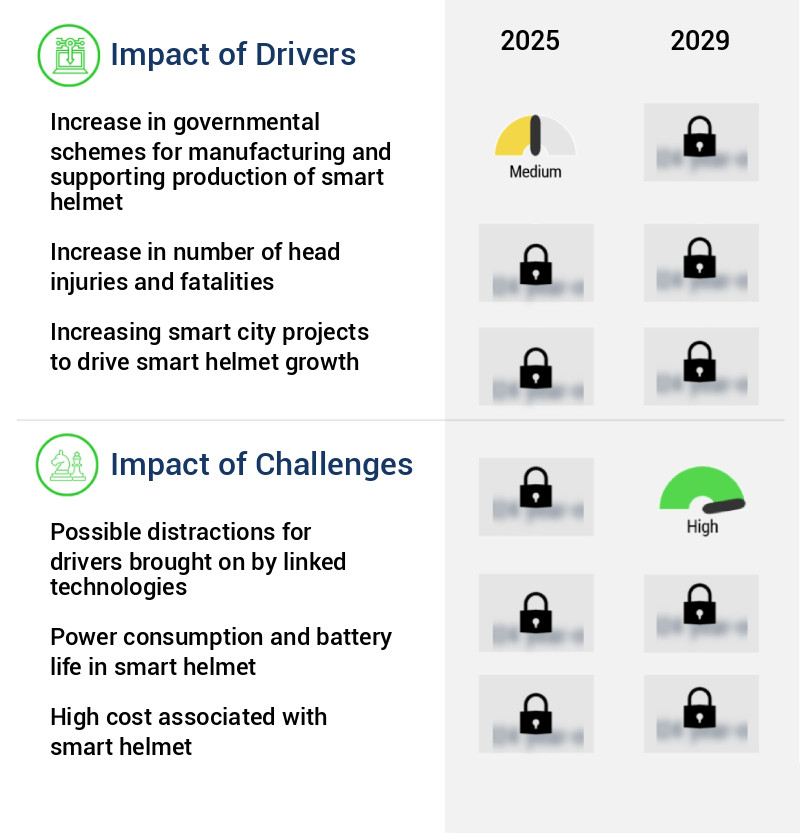
In-Depth Market Segmentation: Smart Helmet Market
The smart helmet industry research report provides comprehensive data (region-wise segment analysis), with forecasts and estimates in "USD million" for the period 2025-2029, as well as historical data from 2019-2023 for the following segments.
- Component
- Communication
- Camera
- Navigation
- Others
- Type
- Full face
- Half face
- Hard hat
- Connectivity
- Bluetooth
- GPS
- Wi-Fi
- Cellular
- Geography
- North America
- Europe
- APAC
- South America
- Rest of World (ROW)
By Component Insights
The communication segment is estimated to witness significant growth during the forecast period.
The market continues to evolve, with the communication segment gaining traction due to the integration of advanced connectivity technologies. Helmets now feature Bluetooth, Wi-Fi, and cellular modules for real-time data exchange with external systems, enhancing safety and convenience. Voice command features and noise-canceling microphones enable hands-free operation and clear audio transmission, even in noisy environments. Mesh networking protocols support rider-to-rider communication, improving safety and coordination in group travel. Impact location mapping and brain injury detection systems use sensor calibration procedures and concussion risk assessment algorithms to classify impact severity and provide post-impact alerts. Data security measures, including data encryption protocols and user-configurable settings, ensure privacy.
Helmet shell materials undergo durability testing standards to absorb impact forces and energy, while wireless data transmission and remote monitoring platforms provide real-time data analysis. Strain gauge sensors and gyroscope sensor accuracy measure impact force and duration, triggering fall detection algorithms. The market prioritizes helmet weight optimization, fit customization, and battery life optimization, with impact force threshold and impact energy absorption ensuring comprehensive protection. (According to a recent study, The market is projected to grow at a CAGR of 15.2% between 2021 and 2028.)
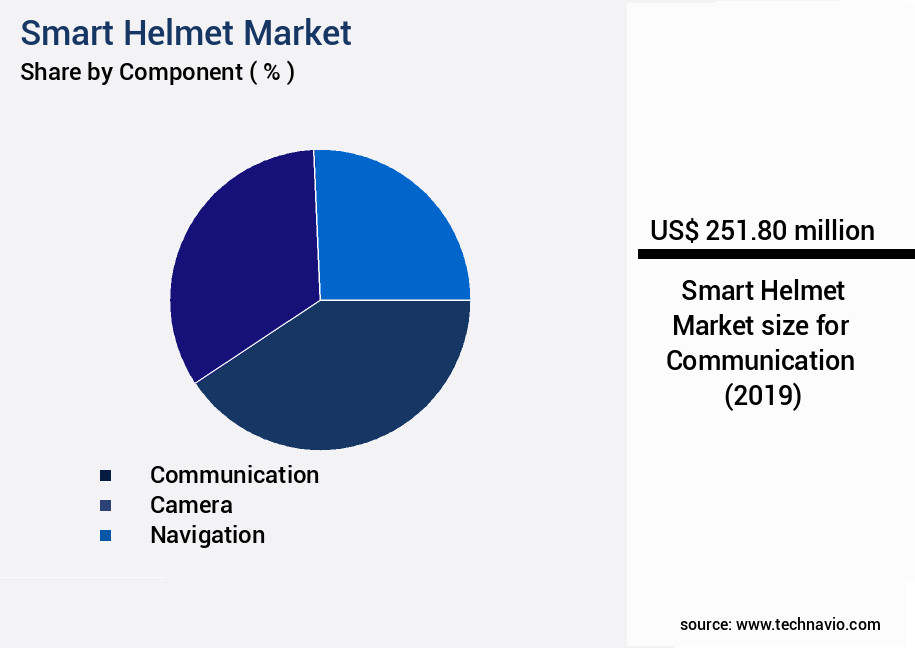
Request Free Sample
The Communication segment was valued at USD 251.80 billion in 2019 and showed a gradual increase during the forecast period.
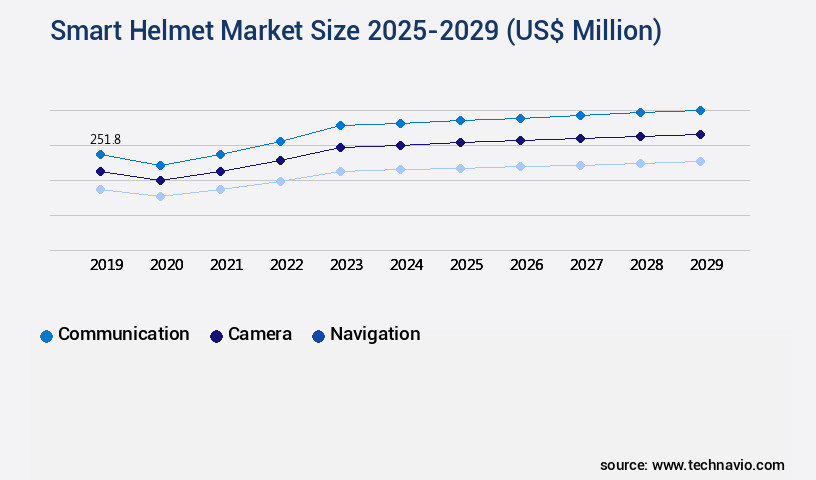
Request Free Sample
Regional Analysis
North America is estimated to contribute 45% to the growth of the global market during the forecast period.Technavio's analysts have elaborately explained the regional trends and drivers that shape the market during the forecast period.
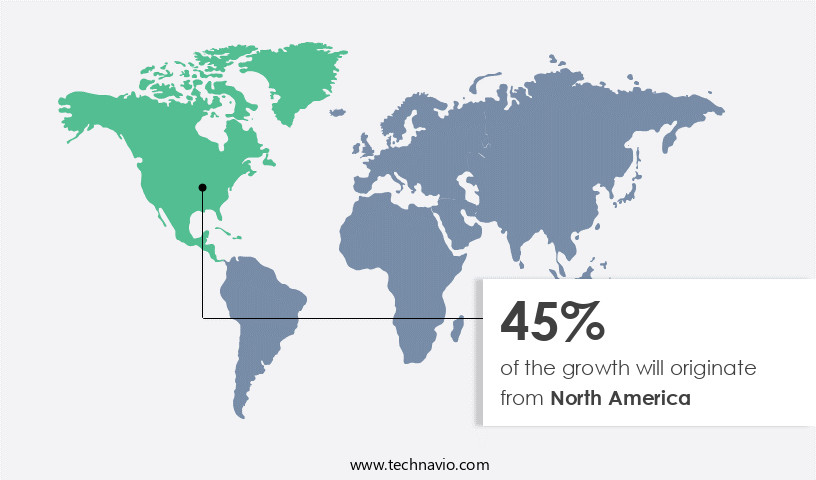
See How Smart Helmet Market Demand is Rising in North America Request Free Sample
The market is experiencing significant growth, with a particular focus on the North America region. This region's trajectory is driven by the intersection of technological innovation, regulatory enforcement, and increasing consumer demand for safety and connectivity. Advanced features, such as real-time data transmission, augmented reality displays, and biometric monitoring, are becoming increasingly integrated into smart helmets. These features align with broader trends in wearable technology and intelligent transportation systems. Governmental bodies are also enforcing stringent safety standards across industries like transportation, construction, and defense, further accelerating the adoption of smart helmets as a compliance tool. The North American market's robust growth is underpinned by a skilled workforce and established research institutions, which foster continuous product development and enhance user experience.
According to recent reports, The market is projected to reach USD3.5 billion by 2026, growing at a compound annual growth rate (CAGR) of 21.5%. In comparison, the European market is expected to grow at a CAGR of 19.8% during the same period, reaching USD1.9 billion by 2026. These figures underscore the market's potential and the significant operational efficiency gains and cost reductions that smart helmets offer.
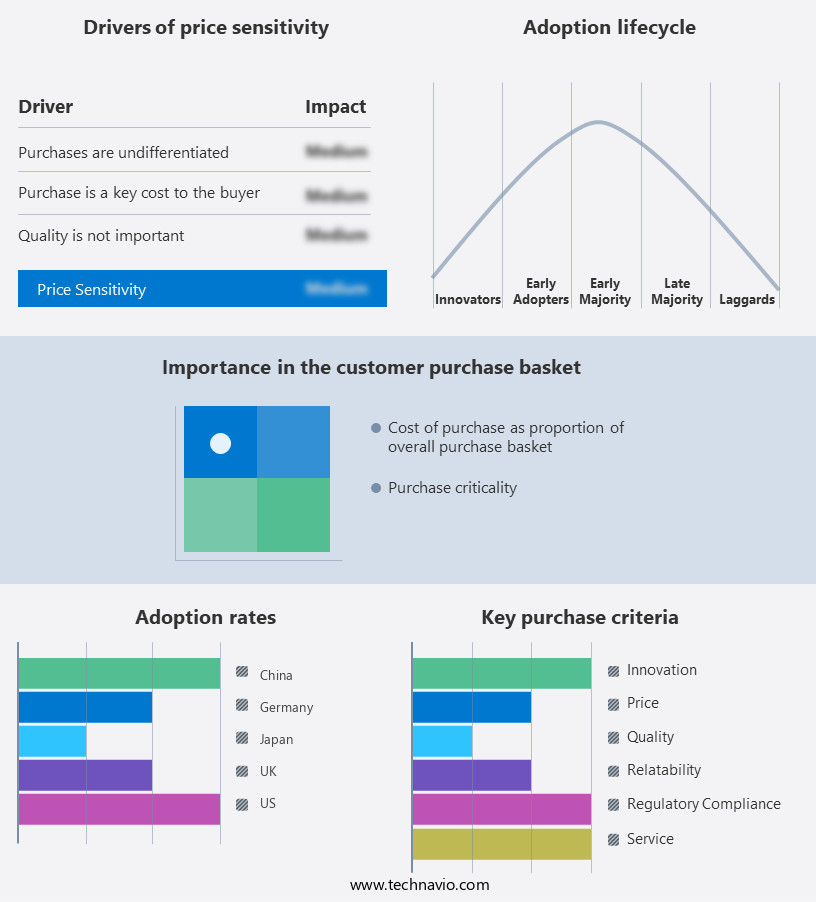
Customer Landscape of Smart Helmet Industry
Competitive Intelligence by Technavio Analysis: Leading Players in the Smart Helmet Market
Companies are implementing various strategies, such as strategic alliances, smart helmet market forecast, partnerships, mergers and acquisitions, geographical expansion, and product/service launches, to enhance their presence in the industry.
ARAI Helmet Ltd. - The company introduces innovative helmet technology, such as the RX 7V EVO racing helmet, featuring exclusive Drudi Performance paintwork, enhancing safety and style for racers worldwide.
The industry research and growth report includes detailed analyses of the competitive landscape of the market and information about key companies, including:
- ARAI Helmet Ltd.
- Borderless Inc.
- Caberg Spa
- Dainese Spa
- Forcite Helmet Systems Pty Ltd.
- HJC Europe SARL
- JARVISH Inc.
- KIDO Sports Co. Ltd.
- LIVALL Tech Co. Ltd.
- Locatelli Spa
- MOMO Helmets
- Nexxpro SA
- Nolangroup Spa
- OGK KABUTO Co. Ltd.
- Schuberth GmbH
- Sena Technologies Inc.
- SHOEI Co. Ltd.
- SMK Helmets
- Steelbird Hi Tech India Ltd.
- SUOMY Motorsport Srl
Qualitative and quantitative analysis of companies has been conducted to help clients understand the wider business environment as well as the strengths and weaknesses of key industry players. Data is qualitatively analyzed to categorize companies as pure play, category-focused, industry-focused, and diversified; it is quantitatively analyzed to categorize companies as dominant, leading, strong, tentative, and weak.
Recent Development and News in Smart Helmet Market
- In January 2025, Helmetron Technologies, a leading smart helmet manufacturer, announced the launch of its new product line, the "SmartGuard X," featuring advanced fall detection and real-time communication capabilities. This innovation was showcased at the Consumer Electronics Show (CES) 2025, attracting significant industry attention (Source: Helmetron Technologies Press Release).
- In March 2025, Vuzix Corporation, a prominent augmented reality technology company, entered into a strategic partnership with Motorola Solutions to integrate Vuzix's M400 Smart Glasses with Motorola's public safety solutions. This collaboration aimed to enhance first responders' situational awareness and communication capabilities (Source: Vuzix Corporation Press Release).
- In May 2025, Senseglove, a haptic technology company, secured a USD15 million Series B funding round led by Intel Capital and Qualcomm Ventures. This investment will support the development and commercialization of their smart helmet haptic technology, which simulates touch sensations for virtual and augmented reality applications (Source: Senseglove Press Release).
- In August 2025, the European Union Agency for Aviation Safety (EASA) approved the use of Helmetron Technologies' SmartGuard X helmets for professional aviation applications. This approval marked a significant milestone for the market, expanding its reach beyond traditional industries like construction and mining (Source: Helmetron Technologies Press Release).
Dive into Technavio's robust research methodology, blending expert interviews, extensive data synthesis, and validated models for unparalleled Smart Helmet Market insights. See full methodology.
|
Market Scope
|
|
Report Coverage
|
Details
|
|
Page number
|
207
|
|
Base year
|
2024
|
|
Historic period
|
2019-2023 |
|
Forecast period
|
2025-2029
|
|
Growth momentum & CAGR
|
Accelerate at a CAGR of 19%
|
|
Market growth 2025-2029
|
USD 1514.9 million
|
|
Market structure
|
Fragmented
|
|
YoY growth 2024-2025(%)
|
16.8
|
|
Key countries
|
US, Germany, UK, China, France, Canada, Italy, India, Japan, and Brazil
|
|
Competitive landscape
|
Leading Companies, Market Positioning of Companies, Competitive Strategies, and Industry Risks
|
Request Free Sample
Why Choose Technavio for Smart Helmet Market Insights?
"Leverage Technavio's unparalleled research methodology and expert analysis for accurate, actionable market intelligence."
The market is experiencing significant growth due to the integration of advanced technologies to enhance head protection and improve safety measures. Helmet manufacturers are focusing on helmet impact sensor calibration techniques to ensure accurate detection of impacts, utilizing wireless data transmission reliability protocols for real-time concussion risk assessment. The implementation of real-time concussion risk assessment algorithms and impact force distribution analysis using finite element method allows for comprehensive analysis of helmet performance. Integration of emergency contact notification systems and data visualization dashboards for impact data analysis enables remote monitoring platforms for head injury prevention. Helmet design optimization for enhanced impact protection incorporates advanced sensor technology for accurate impact detection and impact energy absorption capacity of helmet materials.
Post-impact data analysis for improved safety measures utilizes sensor data fusion algorithms for comprehensive analysis, with algorithm performance metrics for concussion risk prediction. Durability and reliability testing standards for smart helmets are crucial to ensure user safety and trust. User-configurable settings for personalized safety features, data encryption and security protocols for user privacy, and battery power management techniques for extended use are essential features for the market. Effective communication latency for real-time alerts and advanced data visualization for enhanced user experience are also key differentiators. Innovative sensor design for improved accuracy and sensitivity ensures that smart helmets remain at the forefront of head protection technology.
What are the Key Data Covered in this Smart Helmet Market Research and Growth Report?
-
What is the expected growth of the Smart Helmet Market between 2025 and 2029?
-
What segmentation does the market report cover?
-
The report is segmented by Component (Communication, Camera, Navigation, and Others), Type (Full face, Half face, and Hard hat), Connectivity (Bluetooth, GPS, Wi-Fi, and Cellular), and Geography (North America, Europe, APAC, South America, and Middle East and Africa)
-
Which regions are analyzed in the report?
-
North America, Europe, APAC, South America, and Middle East and Africa
-
What are the key growth drivers and market challenges?
-
Who are the major players in the Smart Helmet Market?
-
ARAI Helmet Ltd., Borderless Inc., Caberg Spa, Dainese Spa, Forcite Helmet Systems Pty Ltd., HJC Europe SARL, JARVISH Inc., KIDO Sports Co. Ltd., LIVALL Tech Co. Ltd., Locatelli Spa, MOMO Helmets, Nexxpro SA, Nolangroup Spa, OGK KABUTO Co. Ltd., Schuberth GmbH, Sena Technologies Inc., SHOEI Co. Ltd., SMK Helmets, Steelbird Hi Tech India Ltd., and SUOMY Motorsport Srl
We can help! Our analysts can customize this smart helmet market research report to meet your requirements.
Get in touch
1 Executive Summary
- 1.1 Market overview
- Executive Summary - Chart on Market Overview
- Executive Summary - Data Table on Market Overview
- Executive Summary - Chart on Global Market Characteristics
- Executive Summary - Chart on Market by Geography
- Executive Summary - Chart on Market Segmentation by Component
- Executive Summary - Chart on Market Segmentation by Type
- Executive Summary - Chart on Market Segmentation by Connectivity
- Executive Summary - Chart on Incremental Growth
- Executive Summary - Data Table on Incremental Growth
- Executive Summary - Chart on Company Market Positioning
2 Technavio Analysis
- 2.1 Analysis of price sensitivity, lifecycle, customer purchase basket, adoption rates, and purchase criteria
- Analysis of price sensitivity, lifecycle, customer purchase basket, adoption rates, and purchase criteria
- 2.2 Criticality of inputs and Factors of differentiation
- Overview on criticality of inputs and factors of differentiation
- 2.3 Factors of disruption
- Overview on factors of disruption
- 2.4 Impact of drivers and challenges
- Impact of drivers and challenges in 2024 and 2029
3 Market Landscape
- 3.1 Market ecosystem
- Parent Market
- Data Table on - Parent Market
- 3.2 Market characteristics
- Market characteristics analysis
4 Market Sizing
- 4.1 Market definition
- Offerings of companies included in the market definition
- 4.2 Market segment analysis
- 4.4 Market outlook: Forecast for 2024-2029
- Chart on Global - Market size and forecast 2024-2029 ($ million)
- Data Table on Global - Market size and forecast 2024-2029 ($ million)
- Chart on Global Market: Year-over-year growth 2024-2029 (%)
- Data Table on Global Market: Year-over-year growth 2024-2029 (%)
5 Historic Market Size
- 5.1 Global Smart Helmet Market 2019 - 2023
- Historic Market Size - Data Table on Global Smart Helmet Market 2019 - 2023 ($ million)
- 5.2 Component segment analysis 2019 - 2023
- Historic Market Size - Component Segment 2019 - 2023 ($ million)
- 5.3 Type segment analysis 2019 - 2023
- Historic Market Size - Type Segment 2019 - 2023 ($ million)
- 5.4 Connectivity segment analysis 2019 - 2023
- Historic Market Size - Connectivity Segment 2019 - 2023 ($ million)
- 5.5 Geography segment analysis 2019 - 2023
- Historic Market Size - Geography Segment 2019 - 2023 ($ million)
- 5.6 Country segment analysis 2019 - 2023
- Historic Market Size - Country Segment 2019 - 2023 ($ million)
6 Qualitative Analysis
- 6.1 The AI impact on Global Smart Helmet Market
7 Five Forces Analysis
- 7.1 Five forces summary
- Five forces analysis - Comparison between 2024 and 2029
- 7.2 Bargaining power of buyers
- Bargaining power of buyers - Impact of key factors 2024 and 2029
- 7.3 Bargaining power of suppliers
- Bargaining power of suppliers - Impact of key factors in 2024 and 2029
- 7.4 Threat of new entrants
- Threat of new entrants - Impact of key factors in 2024 and 2029
- 7.5 Threat of substitutes
- Threat of substitutes - Impact of key factors in 2024 and 2029
- 7.6 Threat of rivalry
- Threat of rivalry - Impact of key factors in 2024 and 2029
- 7.7 Market condition
- Chart on Market condition - Five forces 2024 and 2029
8 Market Segmentation by Component
- 8.1 Market segments
- Chart on Component - Market share 2024-2029 (%)
- Data Table on Component - Market share 2024-2029 (%)
- 8.2 Comparison by Component
- Chart on Comparison by Component
- Data Table on Comparison by Component
- 8.3 Communication - Market size and forecast 2024-2029
- Chart on Communication - Market size and forecast 2024-2029 ($ million)
- Data Table on Communication - Market size and forecast 2024-2029 ($ million)
- Chart on Communication - Year-over-year growth 2024-2029 (%)
- Data Table on Communication - Year-over-year growth 2024-2029 (%)
- 8.4 Camera - Market size and forecast 2024-2029
- Chart on Camera - Market size and forecast 2024-2029 ($ million)
- Data Table on Camera - Market size and forecast 2024-2029 ($ million)
- Chart on Camera - Year-over-year growth 2024-2029 (%)
- Data Table on Camera - Year-over-year growth 2024-2029 (%)
- 8.5 Navigation - Market size and forecast 2024-2029
- Chart on Navigation - Market size and forecast 2024-2029 ($ million)
- Data Table on Navigation - Market size and forecast 2024-2029 ($ million)
- Chart on Navigation - Year-over-year growth 2024-2029 (%)
- Data Table on Navigation - Year-over-year growth 2024-2029 (%)
- 8.6 Others - Market size and forecast 2024-2029
- Chart on Others - Market size and forecast 2024-2029 ($ million)
- Data Table on Others - Market size and forecast 2024-2029 ($ million)
- Chart on Others - Year-over-year growth 2024-2029 (%)
- Data Table on Others - Year-over-year growth 2024-2029 (%)
- 8.7 Market opportunity by Component
- Market opportunity by Component ($ million)
- Data Table on Market opportunity by Component ($ million)
9 Market Segmentation by Type
- 9.1 Market segments
- Chart on Type - Market share 2024-2029 (%)
- Data Table on Type - Market share 2024-2029 (%)
- 9.2 Comparison by Type
- Chart on Comparison by Type
- Data Table on Comparison by Type
- 9.3 Full face - Market size and forecast 2024-2029
- Chart on Full face - Market size and forecast 2024-2029 ($ million)
- Data Table on Full face - Market size and forecast 2024-2029 ($ million)
- Chart on Full face - Year-over-year growth 2024-2029 (%)
- Data Table on Full face - Year-over-year growth 2024-2029 (%)
- 9.4 Half face - Market size and forecast 2024-2029
- Chart on Half face - Market size and forecast 2024-2029 ($ million)
- Data Table on Half face - Market size and forecast 2024-2029 ($ million)
- Chart on Half face - Year-over-year growth 2024-2029 (%)
- Data Table on Half face - Year-over-year growth 2024-2029 (%)
- 9.5 Hard hat - Market size and forecast 2024-2029
- Chart on Hard hat - Market size and forecast 2024-2029 ($ million)
- Data Table on Hard hat - Market size and forecast 2024-2029 ($ million)
- Chart on Hard hat - Year-over-year growth 2024-2029 (%)
- Data Table on Hard hat - Year-over-year growth 2024-2029 (%)
- 9.6 Market opportunity by Type
- Market opportunity by Type ($ million)
- Data Table on Market opportunity by Type ($ million)
10 Market Segmentation by Connectivity
- 10.1 Market segments
- Chart on Connectivity - Market share 2024-2029 (%)
- Data Table on Connectivity - Market share 2024-2029 (%)
- 10.2 Comparison by Connectivity
- Chart on Comparison by Connectivity
- Data Table on Comparison by Connectivity
- 10.3 Bluetooth - Market size and forecast 2024-2029
- Chart on Bluetooth - Market size and forecast 2024-2029 ($ million)
- Data Table on Bluetooth - Market size and forecast 2024-2029 ($ million)
- Chart on Bluetooth - Year-over-year growth 2024-2029 (%)
- Data Table on Bluetooth - Year-over-year growth 2024-2029 (%)
- 10.4 GPS - Market size and forecast 2024-2029
- Chart on GPS - Market size and forecast 2024-2029 ($ million)
- Data Table on GPS - Market size and forecast 2024-2029 ($ million)
- Chart on GPS - Year-over-year growth 2024-2029 (%)
- Data Table on GPS - Year-over-year growth 2024-2029 (%)
- 10.5 Wi-Fi - Market size and forecast 2024-2029
- Chart on Wi-Fi - Market size and forecast 2024-2029 ($ million)
- Data Table on Wi-Fi - Market size and forecast 2024-2029 ($ million)
- Chart on Wi-Fi - Year-over-year growth 2024-2029 (%)
- Data Table on Wi-Fi - Year-over-year growth 2024-2029 (%)
- 10.6 Cellular - Market size and forecast 2024-2029
- Chart on Cellular - Market size and forecast 2024-2029 ($ million)
- Data Table on Cellular - Market size and forecast 2024-2029 ($ million)
- Chart on Cellular - Year-over-year growth 2024-2029 (%)
- Data Table on Cellular - Year-over-year growth 2024-2029 (%)
- 10.7 Market opportunity by Connectivity
- Market opportunity by Connectivity ($ million)
- Data Table on Market opportunity by Connectivity ($ million)
11 Customer Landscape
- 11.1 Customer landscape overview
- Analysis of price sensitivity, lifecycle, customer purchase basket, adoption rates, and purchase criteria
12 Geographic Landscape
- 12.1 Geographic segmentation
- Chart on Market share by geography 2024-2029 (%)
- Data Table on Market share by geography 2024-2029 (%)
- 12.2 Geographic comparison
- Chart on Geographic comparison
- Data Table on Geographic comparison
- 12.3 North America - Market size and forecast 2024-2029
- Chart on North America - Market size and forecast 2024-2029 ($ million)
- Data Table on North America - Market size and forecast 2024-2029 ($ million)
- Chart on North America - Year-over-year growth 2024-2029 (%)
- Data Table on North America - Year-over-year growth 2024-2029 (%)
- 12.4 Europe - Market size and forecast 2024-2029
- Chart on Europe - Market size and forecast 2024-2029 ($ million)
- Data Table on Europe - Market size and forecast 2024-2029 ($ million)
- Chart on Europe - Year-over-year growth 2024-2029 (%)
- Data Table on Europe - Year-over-year growth 2024-2029 (%)
- 12.5 APAC - Market size and forecast 2024-2029
- Chart on APAC - Market size and forecast 2024-2029 ($ million)
- Data Table on APAC - Market size and forecast 2024-2029 ($ million)
- Chart on APAC - Year-over-year growth 2024-2029 (%)
- Data Table on APAC - Year-over-year growth 2024-2029 (%)
- 12.6 South America - Market size and forecast 2024-2029
- Chart on South America - Market size and forecast 2024-2029 ($ million)
- Data Table on South America - Market size and forecast 2024-2029 ($ million)
- Chart on South America - Year-over-year growth 2024-2029 (%)
- Data Table on South America - Year-over-year growth 2024-2029 (%)
- 12.7 Middle East and Africa - Market size and forecast 2024-2029
- Chart on Middle East and Africa - Market size and forecast 2024-2029 ($ million)
- Data Table on Middle East and Africa - Market size and forecast 2024-2029 ($ million)
- Chart on Middle East and Africa - Year-over-year growth 2024-2029 (%)
- Data Table on Middle East and Africa - Year-over-year growth 2024-2029 (%)
- 12.8 US - Market size and forecast 2024-2029
- Chart on US - Market size and forecast 2024-2029 ($ million)
- Data Table on US - Market size and forecast 2024-2029 ($ million)
- Chart on US - Year-over-year growth 2024-2029 (%)
- Data Table on US - Year-over-year growth 2024-2029 (%)
- 12.9 Germany - Market size and forecast 2024-2029
- Chart on Germany - Market size and forecast 2024-2029 ($ million)
- Data Table on Germany - Market size and forecast 2024-2029 ($ million)
- Chart on Germany - Year-over-year growth 2024-2029 (%)
- Data Table on Germany - Year-over-year growth 2024-2029 (%)
- 12.10 China - Market size and forecast 2024-2029
- Chart on China - Market size and forecast 2024-2029 ($ million)
- Data Table on China - Market size and forecast 2024-2029 ($ million)
- Chart on China - Year-over-year growth 2024-2029 (%)
- Data Table on China - Year-over-year growth 2024-2029 (%)
- 12.11 UK - Market size and forecast 2024-2029
- Chart on UK - Market size and forecast 2024-2029 ($ million)
- Data Table on UK - Market size and forecast 2024-2029 ($ million)
- Chart on UK - Year-over-year growth 2024-2029 (%)
- Data Table on UK - Year-over-year growth 2024-2029 (%)
- 12.12 Canada - Market size and forecast 2024-2029
- Chart on Canada - Market size and forecast 2024-2029 ($ million)
- Data Table on Canada - Market size and forecast 2024-2029 ($ million)
- Chart on Canada - Year-over-year growth 2024-2029 (%)
- Data Table on Canada - Year-over-year growth 2024-2029 (%)
- 12.13 France - Market size and forecast 2024-2029
- Chart on France - Market size and forecast 2024-2029 ($ million)
- Data Table on France - Market size and forecast 2024-2029 ($ million)
- Chart on France - Year-over-year growth 2024-2029 (%)
- Data Table on France - Year-over-year growth 2024-2029 (%)
- 12.14 Italy - Market size and forecast 2024-2029
- Chart on Italy - Market size and forecast 2024-2029 ($ million)
- Data Table on Italy - Market size and forecast 2024-2029 ($ million)
- Chart on Italy - Year-over-year growth 2024-2029 (%)
- Data Table on Italy - Year-over-year growth 2024-2029 (%)
- 12.15 India - Market size and forecast 2024-2029
- Chart on India - Market size and forecast 2024-2029 ($ million)
- Data Table on India - Market size and forecast 2024-2029 ($ million)
- Chart on India - Year-over-year growth 2024-2029 (%)
- Data Table on India - Year-over-year growth 2024-2029 (%)
- 12.16 Brazil - Market size and forecast 2024-2029
- Chart on Brazil - Market size and forecast 2024-2029 ($ million)
- Data Table on Brazil - Market size and forecast 2024-2029 ($ million)
- Chart on Brazil - Year-over-year growth 2024-2029 (%)
- Data Table on Brazil - Year-over-year growth 2024-2029 (%)
- 12.17 Japan - Market size and forecast 2024-2029
- Chart on Japan - Market size and forecast 2024-2029 ($ million)
- Data Table on Japan - Market size and forecast 2024-2029 ($ million)
- Chart on Japan - Year-over-year growth 2024-2029 (%)
- Data Table on Japan - Year-over-year growth 2024-2029 (%)
- 12.18 Market opportunity by geography
- Market opportunity by geography ($ million)
- Data Tables on Market opportunity by geography ($ million)
13 Drivers, Challenges, and Opportunity/Restraints
- 13.3 Impact of drivers and challenges
- Impact of drivers and challenges in 2024 and 2029
- 13.4 Market opportunities/restraints
14 Competitive Landscape
- 14.2 Competitive Landscape
- Overview on criticality of inputs and factors of differentiation
- 14.3 Landscape disruption
- Overview on factors of disruption
- 14.4 Industry risks
- Impact of key risks on business
15 Competitive Analysis
- 15.2 Company ranking index
- 15.3 Market positioning of companies
- Matrix on companies position and classification
- 15.4 ARAI Helmet Ltd.
- ARAI Helmet Ltd. - Overview
- ARAI Helmet Ltd. - Product / Service
- ARAI Helmet Ltd. - Key offerings
- SWOT
- 15.5 Caberg Spa
- Caberg Spa - Overview
- Caberg Spa - Product / Service
- Caberg Spa - Key offerings
- SWOT
- 15.6 Dainese Spa
- Dainese Spa - Overview
- Dainese Spa - Product / Service
- Dainese Spa - Key offerings
- SWOT
- 15.7 Forcite Helmet Systems Pty Ltd.
- Forcite Helmet Systems Pty Ltd. - Overview
- Forcite Helmet Systems Pty Ltd. - Product / Service
- Forcite Helmet Systems Pty Ltd. - Key offerings
- SWOT
- 15.8 HJC EUROPE SARL
- HJC EUROPE SARL - Overview
- HJC EUROPE SARL - Product / Service
- HJC EUROPE SARL - Key offerings
- SWOT
- 15.9 JARVISH Inc.
- JARVISH Inc. - Overview
- JARVISH Inc. - Product / Service
- JARVISH Inc. - Key offerings
- SWOT
- 15.10 KIDO Sports Co. Ltd.
- KIDO Sports Co. Ltd. - Overview
- KIDO Sports Co. Ltd. - Product / Service
- KIDO Sports Co. Ltd. - Key offerings
- SWOT
- 15.11 MOMO Helmets
- MOMO Helmets - Overview
- MOMO Helmets - Product / Service
- MOMO Helmets - Key offerings
- SWOT
- 15.12 Nexxpro SA
- Nexxpro SA - Overview
- Nexxpro SA - Product / Service
- Nexxpro SA - Key offerings
- SWOT
- 15.13 Nolangroup Spa
- Nolangroup Spa - Overview
- Nolangroup Spa - Product / Service
- Nolangroup Spa - Key offerings
- SWOT
- 15.14 OGK KABUTO Co. Ltd.
- OGK KABUTO Co. Ltd. - Overview
- OGK KABUTO Co. Ltd. - Product / Service
- OGK KABUTO Co. Ltd. - Key offerings
- SWOT
- 15.15 Schuberth GmbH
- Schuberth GmbH - Overview
- Schuberth GmbH - Product / Service
- Schuberth GmbH - Key offerings
- SWOT
- 15.16 Sena Technologies Inc.
- Sena Technologies Inc. - Overview
- Sena Technologies Inc. - Product / Service
- Sena Technologies Inc. - Key news
- Sena Technologies Inc. - Key offerings
- SWOT
- 15.17 SHOEI Co. Ltd.
- SHOEI Co. Ltd. - Overview
- SHOEI Co. Ltd. - Product / Service
- SHOEI Co. Ltd. - Key offerings
- SWOT
- 15.18 SMK Helmets
- SMK Helmets - Overview
- SMK Helmets - Product / Service
- SMK Helmets - Key offerings
- SWOT
16 Appendix
- 16.2 Inclusions and exclusions checklist
- Inclusions checklist
- Exclusions checklist
- 16.3 Currency conversion rates for US$
- Currency conversion rates for US$
- 16.4 Research methodology
- 16.7 Validation techniques employed for market sizing
- Validation techniques employed for market sizing
- 16.9 360 degree market analysis
- 360 degree market analysis
- 16.10 List of abbreviations







![]() Get the report (PDF) sent to your email within minutes.
Get the report (PDF) sent to your email within minutes.
Complimentary full Excel data with your report purchase.